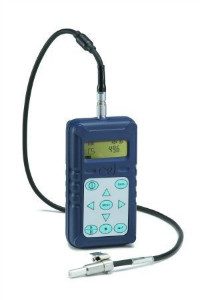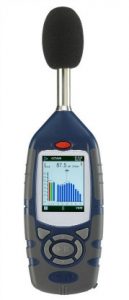Instruments Used to Conduct a Noise Survey
Instruments generally used to measure sound include:
Important factors to consider when dealing with these instruments are instrument settings (App III:A-1), calibration (App III:A-2), and effects of the environment on instrumentation (App III:A-3).
 There are various factors that may indicate noise is a problem in the workplace. While people react differently to noise, subjective responses should not be ignored because they may provide warnings that noise may be at unacceptable levels. A sound level meter (SLM) is the basic instrument for investigating noise levels.
There are various factors that may indicate noise is a problem in the workplace. While people react differently to noise, subjective responses should not be ignored because they may provide warnings that noise may be at unacceptable levels. A sound level meter (SLM) is the basic instrument for investigating noise levels.
Sound Level Meters can be used to:
Spot-check noise dosimeter performance.
Determine an employee’s noise dose whenever use of a noise dosimeter is unavailable or inappropriate.
Identify and evaluate individual noise sources for abatement purposes.
Aid in determining the feasibility of engineering controls for individual noise sources.
Evaluate hearing protectors.
Considerations for Use
Factors to consider with the use of a SLM include:
- When evaluating employee exposures, place the microphone in the hearing zone of the employee being monitored. Additional infromation (App III:B) on general sampling protocol is also available.
- Sound level readings in a nonreverberant environment should be taken in accordance with the manufacturer’s instructions.
- Special considerations (App III:A-4) may be involved with the use and care of a sound level meter.
Measuring Impulse/Impact Sounds
Some meters have a “peak” and “impulse” response for measuring transient sounds (sounds that decay or pass with time).
- The true peak value is the maximum value of the noise waveform. The impulse measurement is an integrated measurement. The true peak reading should only be used when determining compliance with OSHA’s 140 dB peak sound pressure level [29 CFR 1910.95(b)(1) or 29 CFR 1926.52(e)].
- The user should not use “impulse” response when measuring true peak sound pressure levels.
ANSI Standards
Sound level meters used by OSHA meet the American National Standards Institute (ANSI) Standard S1.4-1971 (R1976) or S1.4-1983, “Specifications for Sound Level Meters.” These ANSI standards set performance and accuracy tolerances according to three levels of precision: Types 0, 1, and 2. Type 0 is used in laboratories, Type 1 is used for precision measurements in the field, and Type 2 is used for general-purpose measurements.
Noise Dosimeters:
- Like a sound level meter, a noise Dosimeter can also measure sound levels. However, the dosimeter is actually worn by the employee in order to determine the personal noise dose during the workshift or sampling period.
A Dosimeter can be used to:
- Make compliance measurements according to OSHA’s noise standard
- Measure the employee’s exposure to noise and automatically compute the necessary noise dose calculations.
Factors to consider with the use of a Dosimeter include:
- The microphone must be placed in the employee’s hearing zone. OSHA defines the hearing zone as a sphere with a two-foot diameter surrounding the head. Additional infromation (App III:B) on general sampling protocol is also available.
- Select specific instrument settings (App III:A-5) for the dosimeter.
- Special considerations (App III:A-4) may be involved with the use and care of a dosimeter.
ANSI Standards
S1.25-1991, “Specifications for Personal Noise Dosimeters.”
Some older dosimeters only meet the 1978 version of this standard. The 1978 version was not intended for measuring noise that is predominantly impulsive. For noise that is impulsive in nature, a dosimeter meeting the 1991 version of the standard is recommended.
Octave-band analyzers sound level meters that can be used to:
Help determine the adequacy of various types of frequency-dependant noise controls.
Select hearing protectors because they can measure the amount of attenuation (how much a sound is weakened) offered by the protectors in the octave bands responsible for most of the sound energy in a given situation.
Divide noise into its frequency components
Some sound level meters may have an octave or one-third octave band filter attached or integrated into the instrument. Usually a Type 1 (precision) sound level meter is used for octave and one-third octave analysis.
The filters are used to analyze the frequency content of noise. They are also valuable for the calibration of audiometers and to determine the adequacy of various types of noise control.
Frequency components may include:
Most octave-band filter sets provide filters with the following center frequencies: 31.5, 63, 125, 250, 500, 1,000, 2,000, 4,000, 8,000, and 16,000 Hertz (Hz).
For a more detailed analysis, the spectrum is sometimes measured in one-third octave bands.
The special signature of any given noise can be obtained by taking sound level meter readings at each of the center frequency bands. The results may indicate octave-bands that contain the majority of the total sound power being radiated. Octave Band Analyzers
Source: OSHA


